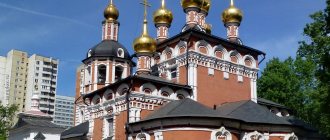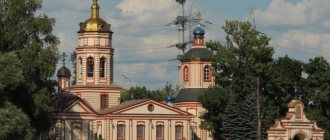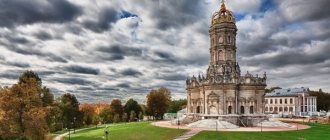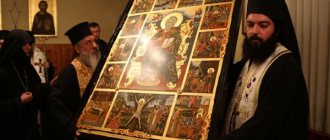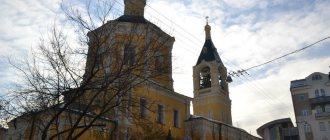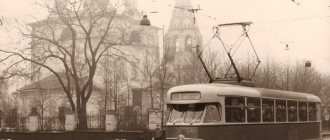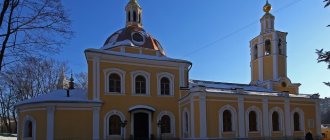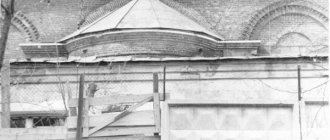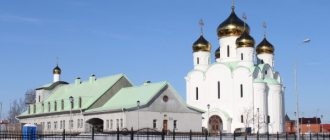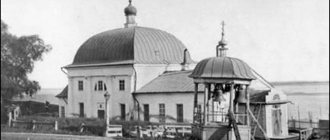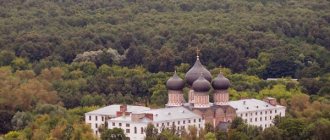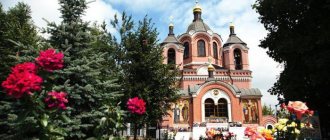Address of the Church of the Life-Giving Trinity in Ostankino
The Church of the Life-Giving Trinity in Ostankino is located on 1st Ostankinskaya street, building 7, building 2.
How to get there by car
By personal car from the center you can go along Mira Avenue to Ostankino Proezd, then along 1st Ostankinskaya Street to the church building. Or another option is along Sheremetyevskaya Street to Argunovskaya, then along Akademika Korolev to Novomoskovskaya, and then along 1st Ostankinskaya Street to the church itself.
From VDNKh along Akademika Korolev Street to the arrow at the 4th traffic light, turn right to 1st Ostankinskaya Street, then at the intersection turn left at the traffic light, and straight ahead 400 m.
How to get there by public transport
The most convenient and easiest way is to get to the station by metro:
- Telecentre distance is 660 m, 10 min walk;
- Academician Korolev Street is a little further, 860 m;
- VDNKh distance is 1.5 km, you can walk it in about 30 minutes. on the street Academician Korolev towards the TV tower, then right along Novomoskovskaya Street, and left along 1st Ostankinskaya to the goal. This route can be shortened a little by taking bus No. 76 or 803 to the rehabilitation center stop, or by tram No. 11 or 17 to the Ostankino stop. You can also take trolleybus No. 9, 13, 36, 37, 69 or 73 to the Akademika Koroleva Street stop.
There is an option to travel by high-speed train in 7 minutes. by monorail from the Exhibition Center to the television center stop, but the train interval is 20 minutes.
Let's sum it up
The history of the Church of the Life-Giving Trinity in Ostankino began back in the 17th century. Like most buildings of that time, this temple was originally wooden. And it could have suffered the difficult fate of many wooden buildings.
But half a century later the building was clad in stone, and in this form it passed through the centuries. Survived the destructive period of Soviet rule, when religion was persecuted. In those difficult times, vegetables were stored in the temple. All icons and valuables were taken away. Atheists were very interested in the precious metal. The temple suffered significant damage.
But at the end of the 20th century, a period of revival of shrines began. Therefore, the temple was not only restored, but all its parishes were consecrated again.
Today it is a majestic building near the Patriarch's Ponds. The picturesque nature is harmoniously combined with the solemnity of the holy faces. There is a Sunday school at the church, welcoming parishioners. There is something to do here for both children and their parents.
Those wishing to visit this attraction can use the metro or personal transport. A trolleybus or tram will take you from the metro station to the church. The temple is ready to receive believers every day.
History of the temple
The Church of the Life-Giving Trinity in Ostankino was erected more than 300 years ago with the blessing of the Moscow Patriarch Iakim, given to the owner of the estate, Prince Mikhail Cherkassky, for the construction of a stone building, instead of a wooden rural church.
The estate in Ostankino at that time was the main residence of the large Cherkasy landowners near Moscow, who owned more than 9 thousand peasant households.
The newly built stone patterned church in the immediate vicinity of the manor house was used as a home church. The northern border was consecrated in 1683 in honor of the Tikhvin Icon of the Mother of God, 8 years later the southern border was consecrated in the name of St. Alexander of Svir, and a year later the central border was consecrated in honor of the Life-Giving Trinity.
Later, the estate went as a dowry to Varvara’s daughter to the Sheremetyev princes, who were carrying out work on the reconstruction and expansion of the church building.
The royal people visited the Cherkasy home church many times, stopping for prayer at the estate located on the route to the Trinity-Sergius Lavra:
- Imperial visit of Anna Ioannovna in July 1730;
- Empress Elizaveta Petrovna visited 4 times in 1742;
- There were repeated royal visits from Nicholas I;
- Emperor Alexander II fasted with his family for several days in August 1856.
People of different classes, not excluding many noble persons, strolled with pleasure in the lovely Ostankino groves. A pleasure garden was opened here for public walks with covered gazebos and decorative sculptures.
After the revolution, the poor and small parish moved from the upper altars to the basement, where the 4th limit of St. Nicholas the Wonderworker was consecrated. In the 20s of the 20th century, the temple was in great need. All church utensils, valuables and silver frames with a total weight of over 4 pounds are confiscated from it.
Since 1930, the church has been closed, and the building housed a museum of anti-religious art, which saved the unique structure and some shrines. During the war period it is used as a warehouse and storage for valuable palace property.
The installation of central water heating and a faulty pipeline led to increased humidity in the building, which resulted in the destruction of foundations and walls.
By the 80s, the iconostasis and wall paintings were being restored, and repair work was being carried out on the roof and facades of the building. Concert performances by a chamber ensemble of sacred and secular music of the 17th century are held in the spacious church building.
In 91, the central limit of the Trinity Church was re-lit by Patriarch Alexy II, and the remaining limits were soon restored and consecrated. For quite a long time it was the courtyard of the Optina Pustyn monastery, and today it is the courtyard of the Moscow Patriarch.
New life for the temple
The Church of the Life-Giving Trinity in Ostankino, built of stone, was created with three chapels:
- the main one was intended to glorify the Life-Giving Trinity;
- the northern one had the role of venerating the Tikhvin Icon of the Mother of God;
- to the south - to preserve the memory of Saint Alexander of Svirsky.
It is noteworthy that it was this temple that Alexander II chose to read prayers before he was crowned king.
Architect and Exterior Decoration
The exact authorship of the church building project has not been fully established. It is assumed that the Trinity Church was erected by a serf architect from the Novgorod province Pavel Sidorovich Potekhin, who carried out many orders of Prince Odoevsky, who was Cherkassky’s father-in-law.
Church of the Life-Giving Trinity before and after restoration
His style is characterized by the contrast of a clear and simple geometry of a square plan with a bright picturesque richness of volume; the transitions to the vaults are emphasized by a wide belt and elegant carved cornices.
The external complex and intricate decoration of the facades with tiles is replete with lush decorative elements and ornaments in the style of Moscow patterning. Icons of the Savior, the Mother of God, Nicholas the Pleasant and Jonah the Baptist also decorate the external church walls.
The windows are decorated with multi-profile platbands with openwork carved patterns, stars or crowns. White stone is used in the decoration of the vertical corner blades, which adds exquisite elegance and freshness to the building.
The niches are clearly arranged in 2 rows. Belts of small flies in 4 rows cover the entire perimeter of the quadrangle, including the gallery. The figure-octagon is decorated with the same 2-row belt. The belfry tier with arched openings is lavishly decorated with brick details. The profile kokoshniks are designed in a similar way.
Architectural ensemble
Structurally, the temple is a pillarless quadrangle, typical of that time, with 2 side volumes on a high common plinth (basement). Compositionally, the structure is characterized by strict symmetry. The building is surrounded on 3 sides by a covered gallery. From the west, a bell tower with a hipped roof rises above the porch.
What is original is the absence of a refectory and the isolation of the inner church premises from the main building by piers. The entrance is decorated with a high elegant porch, richly decorated with a tent.
The domes with an increased depth of domes and a reduced width of the base of the drums also add originality to the building. There are 7 domes in total: 5 above the central part and one above each of the limits. The bell selection of 12 unique bells from the 18th – 19th centuries, preserved during the museum period, has now been returned to the church belfry.
The architecture of the temple harmoniously combined the features of different schools of Yaroslavl, Kostroma and Novgorod masters.
Interior decoration
The iconostasis of the church was created at the end of the 17th century, consists of 9 unique rows, looks like an organ, with icon openings of different sizes. The icons are decorated with end-to-end gilded carvings, the columns are decorated with carved baroque rings with twisted grape vines.
The 13.5 m high iconostasis has survived to this day in almost its original form with very minor changes. The lower tier is represented by images of Hellenic sages, who heralded the coming of the Savior with inscriptions on scrolls in their hands.
The upper tiers contain 16 images of the suffering of Christ, which is considered the most complete known cycle of icons on this topic. At the beginning of the 19th century, the whitewashed walls of the central temple were painted by serf master Ivan Podklyushnikov with religious scenes from the Old and New Testaments.
The porch wall paintings from the 1880s have survived to this day.
The central church displays a wooden carved Pietà of the Lamentation of Christ from the abolished neighboring village church.
Shrines and relics of the temple
The Church of the Life-Giving Trinity in Ostankino boasts ancient unique shrines of the 17th century:
- Trinity icon of the Old Testament image;
- The Mother of God Chernigov face is still from the wooden Ostankino church;
- The Feodorovskaya icon was copied from the image of the Ipatiev Monastery;
- The miraculous face of the Georgian Mother of God is double-sided, on the reverse there are images of the Great Saints;
- Icon of the Last Supper over the Royal Doors of the Trinity Boundary.
The miraculous Kazan Mother of God image was transferred from the local museum of the work of serf craftsmen. The temple reliquary has been compiled since the resumption of the history of church services. A particularly revered place in it belongs to the holy pieces of the relics of the famous elders of Optina Pustyn.
In the Svir region there is an icon with a piece of the relics of the Holy Blessed Princess Anna Kashinskaya, donated by the local deputy district head in the 90s. The image of the Holy Queen Elena was commissioned and donated to the church by the husband of the deceased parishioner of the temple Elena Voropaeva in 2004.
Due to numerous requests from parishioners, the revered image of the Inexhaustible Chalice appears in the church, where prayer services are also regularly served with the reading of akathists.
Mentors
The rector of the temple and the monastery courtyard during the period of resumption of services until 2009 was Hieromonk Theophylact Bezukladnikov, and after him, from April to the present day, Sergius (Chashin), elevated to the rank of Metropolitan of Singapore and Southeast Asia, has been rector.
The clergy today consists of 2 archpriests, 3 priests and a deacon.
Church of the Holy Trinity in Ostankino: introduction
It has been decorating the city for over three hundred years. The history of the Church of the Life-Giving Trinity in Ostankino is inseparable from the history of the Russian capital. This Orthodox church is the most important monument of cult Old Russian architecture, one of the culminating points in the development of the “Moscow patterned” style. The church in Ostankino belongs to the Russian Orthodox Church (Trinity Deanery of the Moscow Diocese). It is part of a complex of monuments representing the Ostankino museum-estate. The temple was founded by Vasily Yakovlevich Shchelkalov, an influential Duma clerk and statesman under Tsar John IV, in 1558. The date of first mention is 1584. The church was built in the period from 1677 to 1692.
Service schedule, operating hours
The church in Ostankino, known in the area as the Life-Giving Trinity, holds daily services in the morning and evening according to the following schedule.
| Type of worship | Time |
| Prayer service | 8-00 |
| Divine Liturgy | 8-30 |
| Evening service, All-night vigil, Polyeleos | 16-45 |
On Sundays and holidays there are two Liturgies at 6-30 early and at 9-40 late.
Don’t miss the most popular article in the section: Optina Pustyn Monastery - how to get there from Moscow, address, where it is located, history and interesting facts.
Let's go back in time
Among the rural silence of the fields, a red stone structure rises. This is the Church of the Life-Giving Trinity in Ostankino. Now the life of the capital is concentrated here. But the building carefully preserves the memory of the history of its creation.
The building of the Church of the Life-Giving Trinity in Ostankino was originally built from wooden material. But half a century later a stone structure rose here. The Cherkasy princes, who owned the village of Ostankino, built this temple for the local residents. Even then, the building was equipped with an iconostasis, the carved frames of which were gilded.
Rules for visiting the temple
The parish has developed certain rules of behavior when visiting Trinity Church:
- When going to church, a Christian needs to feel spiritual joy, humility and meekness in his soul in order to come out justified and comforted by the Savior.
- When entering a church, it is advisable for a pious layman to make three bows from the waist with a mental prayer to the Lord, and on the days of the Lenten service, bows to the ground are performed.
- It is extremely important to have the fear of God and remember the Saints depicted on temple icons, therefore it is necessary to look decent and behave reverently before their Holy images.
- During church services, it is necessary to stand quietly and silently in one place, listening with diligent attention to the psalms being read and the prayers being said.
- You should absolutely not interfere with other people’s prayers.
- Passing by the Royal Doors, an Orthodox Christian should stop, reverently cross himself and bow.
- It is advisable to enter the church in advance so that before the start of the service you have time to light candles in front of the Holy Images without fuss, as well as submit notes for the health of loved ones and for the remembrance of departed souls of relatives.
- You need to behave especially quietly and reverently during the period of reading the Holy Gospel, the 6th Psalm and after the singing of the Cherubim.
- A lit church candle is a symbol of a Christian’s fiery prayer.
Patronal holidays
The main patronal feast does not have a fixed date and is celebrated on the Day of Pentecost, depending on Easter. 04/30 and 09/12 are the patronal feast days of Alexander of the Svir region.
On July 09, solemn holiday services are held in honor of the Tikhvin Icon of the Mother of God. The lower throne celebrates holidays on the days of the church glorification of St. Nicholas: May 22 and December 19.
Temple holidays are also celebrated:
- in the Svir region in honor of the Georgian icon 04.09;
- on the day of the Chernigov Mother of God Icon, 14.09;
- in the central part of the temple on the days of the Theodore Icon of the Mother of God, 29.08 and 27.03;
- on the days of glorification of the Holy Saints of God, whose parts are kept in the reliquary.
New story
The 20th century brought the temple a period of decline, like many shrines. First, the believers had to leave the upper part and move to the basement. Here a fourth chapel was formed, dedicated to St. Nicholas. In 1922, the church lost all salaries. All the icons and the iconostasis were also taken away. The loss was estimated at almost 60 kg of silver metal.
Later the building was transferred to the disposal of the Anti-Religious Museum. The lower aisle was used as storage for potatoes. When the Great Patriotic War began, the final transformation of the temple into a warehouse took place.
Interesting facts about the temple
The image of the Georgian Mother of God belonged to the Georgian princely family, from which came the abbess of 3 monasteries, schema-abbess Tamar. Later, the icon came to a family friend, Yakov Nemstsveridze, who had a dream of the appearance of the Mother of God with a request to take it to the Trinity Church in Ostankino for peace.
But Yakov wanted to donate the image to the recently opened church on B. Gruzinskaya Street. He tried 3 times to take the icon there, but each time some unexpected force majeure circumstances occurred. At the same time, destructive phenomena began to occur to the image; the paint began to peel off and crumble.
Resigned, the owner of the icon decided to listen and take his favorite image to the Trinity Church in Ostankino. When he first went up to the church, he was immediately greeted by a complete stranger who asked if he had brought the icon of the Georgian Mother of God. The day before, the woman had a vision that the image would miraculously appear in their temple.
And when the restorer began working on the image, the colors fell into place in an amazing way. And during the opening of the forgotten monastery of Mother Thomas in Georgia, the icon in the Ostankino Church began to smell fragrant. Today, regular prayer services are performed in front of the miraculous face with the reading of the akathist.
Holy Trinity
The temple was built in honor of the Holy Trinity. What does this image include? The Holy Trinity is the Father, the Son and the Holy Spirit. But all this is one God, who appears to man in three persons. But according to church canons, only the face that appeared before people can be depicted. Therefore, this is Jesus Christ. This explains the large number of icons depicting the Son of God.
Since the cases of the appearance of the Lord - the Father and the Holy Spirit - to people are not described, it is not allowed to depict them on icons. Some biblical stories tell that people either heard the voice of these forces, or they appeared in the form of a dove. What is certain about the icons of Jesus is that the most ancient of them convey in detail the appearance of the Son of the Lord.
Information for visitors
The Church of the Life-Giving Trinity in Ostankino conducts active educational work with children and youth.
At the temple, in the wing building to the right of the church, there is a Sunday school for children from 5 years of age, a theater club for children over 9 years old, creative workshops for children from 7 years old and adults, a drawing studio and a children's choir. Developmental classes are held for preschoolers from 3 years old, and a why-chek club works for 4-year-olds.
There are “Smart Men and Women” classes and a club for learning English for children from 8 years old. For adults and children over 8 years old who wish, there is an icon painting circle.
For children from 12 years of age, it is possible to visit a teenage club, where on Saturdays there are screenings and discussions of feature films with spiritual and moral themes, conversations about Orthodoxy and Christian life, and useful and interesting leisure activities for young people are organized.
Young people aged 17-34 years old participate in the activities of the youth center, which is held weekly on Sundays from 15 to 19 hours. Participants of the center make pilgrimage trips to monasteries in Russia and the region, actively cooperate with youth centers in other cities, hold sports meetings for parishioners and organize congratulations for the holidays.
On Saturdays from 12 to 16 hours there are classes for adults, where everyone can study the Sacred History of the Old and New Testaments, Liturgics, Iconology, as well as the history of the Church with the Catechism. Pastoral conversations are held weekly on Saturday with everyone interested. Starts at 15:00
If possible, unchurched parents and children are involved in parish holiday events, as well as in the activities of Sunday schools and studios, in order to carry out educational work.
The family club in the Sunday school building invites those wishing to discuss the social and parish life of the church, share exciting moments of psychological direction, child-parent relationships and receive the necessary advice on issues of raising children and family relationships.
The temple has its own television studio and children's press with free classes for everyone.
The clergy of the temple organized social work to help the disabled, the poor and orphans, in which parishioners and members of the youth center take part whenever possible. Charity events and fairs are held to raise funds and things for prisoners, trips are organized for disabled people and children to holy places, and visits are made to patients in nursing hospitals and boarding schools.
The Church of the Life-Giving Trinity carries out social and cultural activities in the Ostankino region, actively involving citizens in joint parish work.
Article design: Vladimir the Great
Center for Spiritual Development
It is characteristic of modern life in the community that the following areas of activity are concentrated here:
- Sunday school, which can be attended by both children from the age of five and adults;
- a youth center where young parishioners who have already reached the age of seventeen are invited;
- children's television studio and press center;
- a social service that supports people with disabilities and low-income orphans living in the Moscow region.
